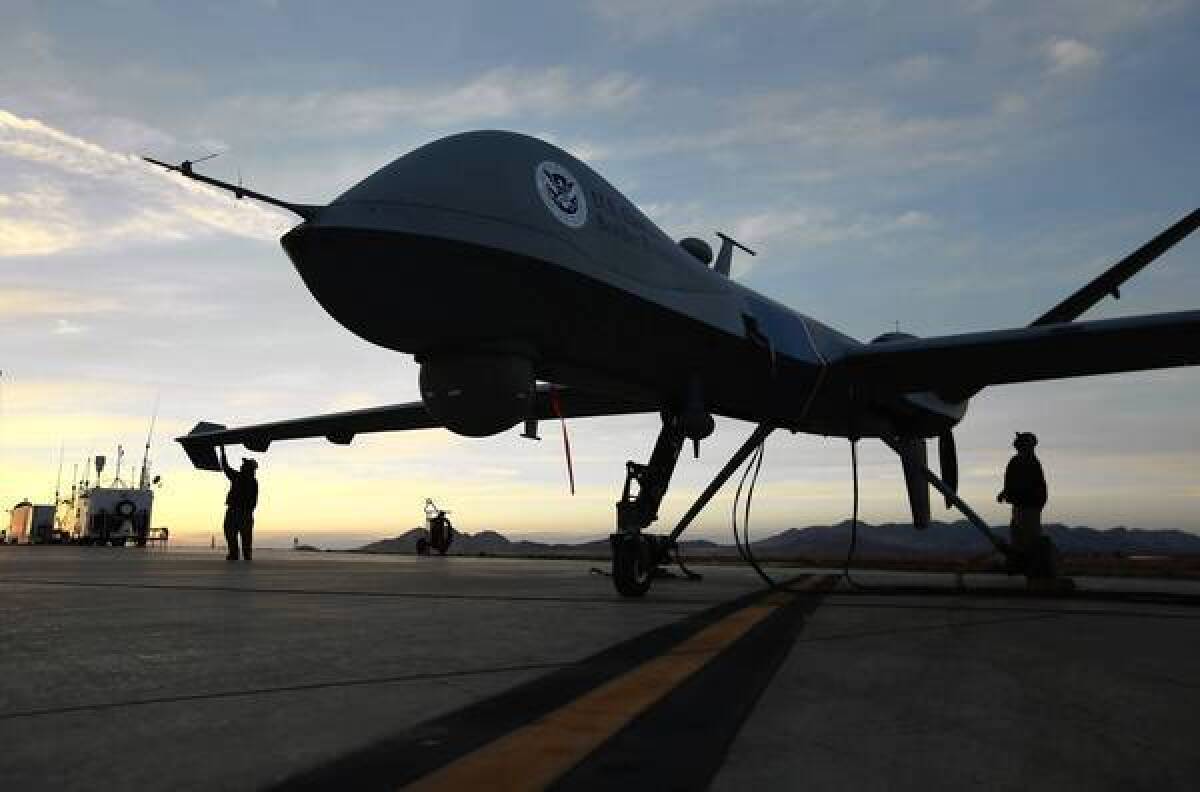States in a race to secure drone testing

- Share via
WASHINGTON — Although the prospect of drones flying over U.S. cities is generating cries of spies in the skies, groups from California to Florida are fiercely competing to become one of six federally designated sites for testing how the remotely piloted aircraft can safely be incorporated into the nation’s airspace.
North Dakota boasts of its “minimal air traffic congestion.” North Carolina, whose license plates read “First in Flight,” cites its aviation history. California pitches its diverse geography: desert, mountains and ocean.
Technically, the designation itself offers no money, but 50 groups in 37 states have entered the Federal Aviation Administration competition. States see the designation as an opportunity to generate jobs from a burgeoning industry.
“Clearly, we wouldn’t be interested unless we thought there was money,” said Bob Knauff, a retired general leading a New York-Massachusetts bid.
And so the pitches keep coming. Oklahoma notes its experience in testing drones for the military. Arizona boasts of its nearly year-round “perfect flying weather.” Florida, on the other hand, sees its sometimes severe weather a plus for testing drones in all kinds of conditions.
And the leader of a joint effort by Alaska, Hawaii and Oregon says, “We think we bring something to the table that is going to be hard to match,” citing the diversity of environments and “massive amounts” of “relatively unpopulated airspace,” especially up in the Last Frontier.
Not everyone, however, is so enthusiastic.
Even as the competition rages, lawmakers from city halls to Congress are writing legislation to restrict drone flights. The FAA also is getting an earful from a public anxious about drones invading their privacy.
“This is a highly visible step toward a Big Brother-like state,” a Wisconsin resident complained to the FAA.
Those vying for test sites say that privacy concerns should be addressed separately from the testing. But they are aware of the concerns.
North Carolina has proposed testing in airspace over crops. “Corn doesn’t care” about drones flying overhead, said Kyle Snyder, director of the NextGen Air Transportation Center at North Carolina State University. Still, the FAA has directed that existing privacy laws be obeyed during testing.
Those bidding for test sites — in many cases alliances of economic development groups, universities and aerospace companies — believe that if they land a test site, drone manufacturers will follow.
Aerospace research firm Teal Group Corp. estimated that worldwide drone spending will almost double over the next decade to $11.4 billion. Thousands of drones are expected to be deployed over the U.S. within the next five years for all sorts of chores, including inspecting pipelines, scouting film locations, searching for lost hikers, helping police track criminal suspects.
“Simply put, unmanned aircraft systems are the next big thing in the aerospace industry,” California Assemblyman Al Muratsuchi (D-Torrance), chairman of the California Assembly Select Committee on Aerospace, said at a recent Sacramento hearing.
Florida, which is investing $1.4 million in its pitch, sees drones as a way to recover from the end of the space shuttle program. Nevada officials have said they see an opportunity to become the “Silicon Valley of unmanned aerial systems.”
The FAA, which will select the six test sites by the end of the year, was directed by Congress to draw up rules by 2015 for drone flights in U.S. airspace. Among those pushing for the legislation was the 49-member Congressional Unmanned Systems Caucus, founded by Rep. Howard P. “Buck” McKeon (R-Santa Clarita), who has cited the potential for jobs and improvements to public safety and emergency response times from integrating drones into the nation’s airspace.
The FAA has largely left it to the applicants to propose the parameters for the test sites.
North Carolina proposes a range just 14 miles long and four miles wide; other states propose ranges that take in hundreds of miles of restricted airspace, generally over lightly populated areas. Two California groups propose testing over the desert and ocean and at small airports.
In Maryland, a group led by the University System of Maryland has proposed testing over the Chesapeake Bay, among other places. New York and Massachusetts propose testing over the Adirondacks and Cape Cod.
Tests initially are expected to focus on small drones, typically 50 pounds or less, flying at altitudes of up to 5,000 to 10,000 feet, but eventually could include bigger drones like the ones used in combat — but unarmed.
Some states hoping to be named test sites have combined forces, seeing strength in numbers. Virginia and New Jersey are working together.
In California, groups based in Ventura and Kern counties, with partners from throughout the state, are bidding to become test sites, but state officials worry the intrastate competition could hurt California’s chances.
Although states aren’t saying much publicly about their bids for fear of helping their competitors, they are looking for any edge they can get.
North Dakota, to highlight its expertise on drones, noted that one of its universities was the first in the nation to offer a bachelor’s degree in “unmanned aircraft systems operations.” The governor has allocated $1 million for the state’s bid and pledged an additional $4 million to support the testing if North Dakota is selected.
Ohio noted that it was home to development of the “world’s first unmanned aerial system,” a sort of flying bomb known as an “aerial torpedo” developed in 1918.
More to Read
Sign up for Essential California
The most important California stories and recommendations in your inbox every morning.
You may occasionally receive promotional content from the Los Angeles Times.











